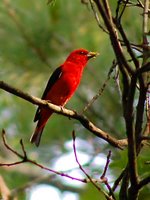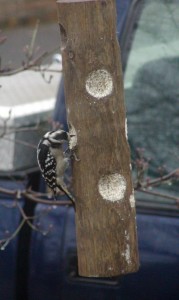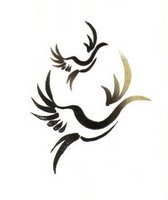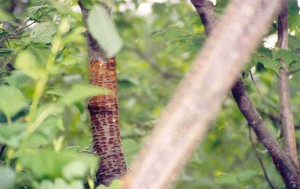 NJ Audubon has recently published a guide to the New Jersey Meadowlands that is available for free. This guide is the second in a series; the first covers the NJ Delaware Bayshore. These are great little books! I mention them now because on my most recent volunteer day at Sandy Hook Bird Observatory I discovered that the new guide had finally arrived, but for some reason, we only had the Spanish-language version in stock. While I’m glad to see that it’s being published in Spanish, I do wonder how many Spanish-speaking birders there are out there to make use of it.
NJ Audubon has recently published a guide to the New Jersey Meadowlands that is available for free. This guide is the second in a series; the first covers the NJ Delaware Bayshore. These are great little books! I mention them now because on my most recent volunteer day at Sandy Hook Bird Observatory I discovered that the new guide had finally arrived, but for some reason, we only had the Spanish-language version in stock. While I’m glad to see that it’s being published in Spanish, I do wonder how many Spanish-speaking birders there are out there to make use of it.
The language teacher and word-lover in me was most interested in how the translators of the guide handled the use of bird names in Spanish. From the little bit that I’ve read on the subject, there currently is no standard method for this type of translation due to the many local variants that are commonly used for bird names. I believe that this guide makes use of the names used in the Spanish version of the Kaufman Field Guide to Birds.
Anyway…. I thought we might have a little fun with this. Translation is more art than science, and involves finding the essence of what a thing is, rather than focusing on the words used to describe it. In other words, a thing is what it is, rather than what it’s called. Many bird names in English seem arbitrary on the surface, but often relate to some characteristic of the bird in question, whether the name be related to how the bird looks or how it feeds or the sound of its voice. For example, the name of the White-breasted Nuthatch describes the bird’s physical appearance as well as making reference to its feeding behavior. The name of the Northern Cardinal likens its color to the vestments worn by some priests. The name of the Scarlet Tanager in part is descriptive of the bird’s color, but what does tanager refer to? Is that an arbitrary term? Couldn’t we just as easily call the Scarlet Tanager the Black-winged Redbird? Would we still know it by that name?
Never having had occasion to use Spanish bird names, I sat down with my dictionary this evening to dissect the Spanish names of a few birds and thought it might make a fun quiz for bird lovers. The 15 bird names that follow are literal translations of the Spanish used to describe them. Similar species are loosely grouped together.
1. Scratching sparrow
2. Chestnut-colored pouch-maker
3. Red-eyed scratcher
4. Fuzzy little carpenter
5. Little whistling plover
6. Orange-throated warbler
7. Blazing/fluttering warbler
8. Sideburned warbler
9. Ground warbler
10. Creeping warbler
11. Spotted thrush
12. Golden-toed egret
13. Scissor-tailed swallow
14. Rainbow duck
15. Nun-like duck
Some of these are very easy, with others you may have to use your imagination. Some bird names were impossible to translate so literally without giving them away, often because the name, like our English one, related to the bird’s call. For example, the Killdeer is called Chorlo Tildío; Chorlo is the family name of Plover, Tildío is the descriptive term and sounds (even in Spanish!) like the Killdeer’s call. Similarly, the Willet is called Playero Pihuihui; Playero is the family name and Pihuihui describes the Willet’s call.
Happy guessing!
Image of the Black-winged Redbird from http://www.flickr.com/photos/trombamarina/179428016/



